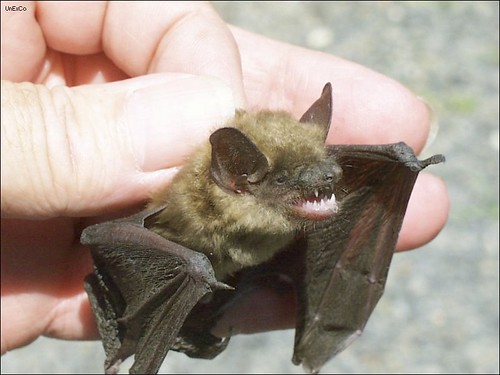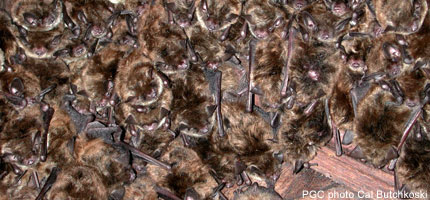
3:19 p.m. - 2007-11-09
Bats!
Hey dewds!
How are you?
As an FYI, my membership to this site is running out, so I will be making a switch soon!
Wildlife news:
Fear linked to sense of smell?
The San Fran oil spill could affect habitat and wildlife well-being.
For a grad school project, my budster GH had to research a nightingale song. There are tons of German Lieder about these "Nachtigall" birdies!
In the Raptor Report, today I spotted a hawk enjoying a carrion meal on the Hwy 55 bridge over Lake Street! Then, PG and I noticed a bald eagle perched near the southeastern shore of Lake Nokomis!
(The flurries in this eagle photo remind me of the real snow that was falling this morning in Minneapolis! It's all gone now.)
Today's creature feature is not really appropriate for the upcoming winter season, but this recent National Geographic article about zoonotic diseases totally freaked me out. It turns out that several viruses, such as SARS, Henipavirus, rabies and possibly Ebola can be transmitted to humans through contact with bats! And also, these flying mammals seem to freak out my cousin, JS!
Part of the Order Chiroptera (from the Greek "cheir" [hand] and "pteron" [wing]), there are 1,100 bat species that make up nearly 20% of Class Mammalia. About 70% of bats are insectivorous, with the remainder being fruit, pollen, blood or animal eaters. Bats are very important nighttime predators, and scientists are discovering some tropical plants which are completely dependent upon bats for pollination and seed distribution.
The Upper Midwest is home to many species of bats. Minnesota natives include the Northern myotis (little brown bat), big brown bat, Eastern pipistrelle, silver haired bat, hoary bat and Eastern red bat. The final three in the list are solitary, forest dudes. Today I will focus on the most common species, the little brown bat and the smaller Eastern pipistrelle.
Side Note: Pipistrelle is Italian for "bat".
Brown bats are 4 to 6 inches long and weigh .19 to .46 ounces. Their wingspan is 8 to 10 inches. Look at all of the sharp bug-eating teeth!
Little brown bats (and all of the bats listed above) eat tiny airborne bugs, such as gnats, right from the sky, but will grab larger insects, such as beetles, with their wing and put the bug into a cup formed by their tail membranes. From there the bat will scoop it into its mouth - while flying! Bats can eat half their weight in insects per night.
Most North American bats have similar lifestyles. In most cases, bats will congregate together and hibernate during the winter, which may involve a mass migration anywhere from 100 miles from their summer homes up to thousands of miles away. Most bats migrate to a hibernatorium, which is a large enclosed space that is relatively warm, like a cave.
During the warmer months, bats have separate day and night (and male and female) roosts. During they day a bat may take occasional shelter in a warm, dark place like a woodpile or hollow tree, a building or a rock cliff. These are often south-facing to encourage restful torpor in the animal. Usually bats feed twice in the night; at dusk and at midnight, so a nighttime roost is also sought. Scientists think bats choose two spots not only for warmth and safety reasons, but also to prevent too much guano to collect in the location of the daytime roosts. The poo could attract unwanted attention from predators.
Bat enemies include people, housecats, weasels, martens, fishers, owls, hawks, snakes and raccoons.
Bat nooky is awesome! Primarily bats mate during August. There are two types of intercourse; first, there is active copulation, where both the males and females are alert, and the male mounts the female from behind. He might emit a soothing supersonic call to soothe her. The other type is passive copulation, where the males are sexually active in a hibernatorium. While the other bats are hibernating, awake males will mount BOTH MALE AND FEMALE BATS. The encounters are homosexual about 35% of the time.
Regardless of when the females receive sperm, delayed implantation allows her to give birth at the same time in the spring. Pregnant bats will gather together in one nursery cave, where they may cluster together more than at other times, as prepartum females are less successful at keeping themselves warm. (This is called thermoregulation.) About 50 to 60 days after implantation, the female gives birth to one (or two) babies. Unlike her usual "upside down" position, a momma bat flips head UP to give birth. Using his claws, teeth and lips, the baby bat, called a pup, latches onto his mother's nipple constantly for the first two weeks of life. After two weeks the pups are too heavy for the mother bat to carry, and the pups are left together in the nursery cave. Using sound and smell recognition, a momma bat can pick out her pup among thousands of babies in the cave!
Fun fact: A lactating bat increases her food intake to 110% of her body weight per night!
After six to eight weeks the baby bat can fly; it seems that the mother might teach it to hunt insects, but scientists aren't sure. Because young bats may not pack on enough weight to survive the winter, about 50% die in their first year of life.
Although the bats in Minnesota aren't threatened, the low bat birth rate contributes to the endangerment of other species around the world.
The Eastern pipistrelle is smaller than the little brown bat, being only 3 inches long with a 8 inch wingspan. Also called butterfly bats because of their fluttery flight patterns, pipistrelles can catch an insect every 2 seconds. They fly up to 11 miles per hour, and can increase their body mass by 25% in only thirty minutes of bug-eating. These smaller guys mostly eat midges, and are most successful finding swarms of bugs and swooping in from about a meter away.
Pipistrelles are different from the little brown bat in that they usually give birth to twins.
Bats are really unique animals and scientists are learning more and more about them. Obviously, human contact with bats should be avoided, but really, they do much more good to the world than harm. I hope the next time you spot one you will send goodwill to our helpful nighttime friends!
Hibernatoria,
Wendell!





